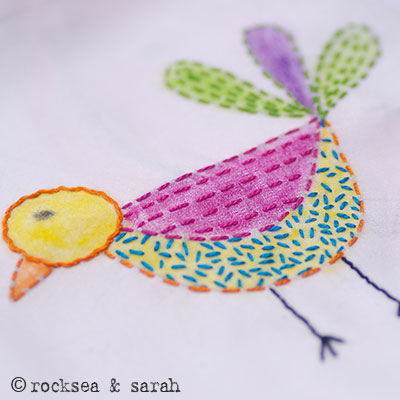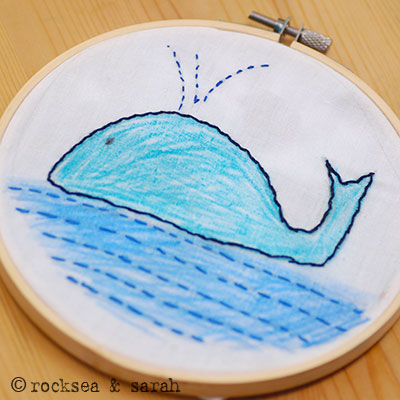Lesson 2: Different stitches and many ways to stitch
This lesson will show how different stitches will look over a colored pattern in this wonderful project for kids. But, to continue with Lesson 2, make sure you have gone through these two Lessons first:
The Introduction. This will answer most of your questions and give an idea of what to expect while doing this project with kids.
Lesson 1. This lesson will teach you what to do before you start stitching in a step- by- step illustration.
 |
TIP: For young learners, the adults can choose to do the Running Stitch, while the kids can weave the variations of their choice over it.
This page will illustrate a few different ways in which you can use the stitches over your patterns. The stitches used here are simple and can be easily done by the kids. Click on the names of each stitch to get to the tutorials
Outlines: Using the different stitches
 |  |
| Running Stitch | Holbein Stitch |
 |  |
| Whipped Running Stitch | Interlaced Running Stitch |
 |  |
| Laced Running Stitch | Looped Running Stitch |
Fillings: Different ways to add texture
 |  |
| Spirals and concentric filling: This provides a beautiful texture to the colored pattern. The stitches can be done in a spiral fashion too. You might have to draw the lines to guide the kids with the stitching. | Striped filling: This is a great way to fill large areas like a background sky. Make the rows of Running Stitch horizontally, vertically, or diagonally. Remember that you can work the Running Stitch variations over it too! |
 | |
| Random filling: This filling is great to provide texture, and add different colors to the pattern. The stitches are wild and there is no rule on how it should be scattered. |
Colors: Different combinations for various effects
 |  |
| Similar colors: This is just a sample of how stitching with a color similar to that of the background would look like. Certain projects can look gorgeous with the same color stitching. Try using different shades and tones of the same color for a graceful look. | Contrasting colors: Using contrasting threads can add a playful tone to the project. A project can turn out really beautiful with a sensible choice of colors. |
Many of these samples were made by my 7-year-old daughter, Parjanya (Origin: Sanskrit; meaning: Monsoon, or source of life). She enjoyed coloring the shapes and stitching around a few of the shapes!
Check the other lessons here
If you need guidance with the basics of threading, knotting, hooping, or tracing, check HERE.











That’ll be very helpful for mu kod. Thanks a bunch!
Wonderful to know, Serpil. Please share the work here. We would be delighted to see it.